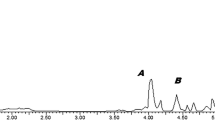Abstract
Urine and vaginal mucus samples from female white-tailed deer in estrus and mid-cycle were analyzed by combined gas chromatography-mass spectrometry (GC-MS). Forty-four volatiles were found in mucus and 63 in urine. The volatiles common to both vaginal mucus and urine included alcohols, aldehydes, furans, ketones, alkanes, and alkenes. Aromatic hydrocarbons were present only in the vaginal mucus, whereas pyrans, amines, esters, and phenols were found only in urine. Both estrous mucus and estrous urine could be identified by the presence of specific compounds not present in mid-cycle samples. Numerous compounds exhibited dependency on ovarian hormones.
Similar content being viewed by others
References
Albone, E.S. 1984. Mammalian Semiochemistry. John Wiley & Sons, New York, 360 pp.
Bakke, J.M., andFigenschou, E. 1990. Volatile compounds from the red deer (Cervus elaphus). Substances secreted via the urine.Comp. Biochem. Physiol. 97A:427–431.
Brown, B.A., andHirth, D.H. 1979. Breeding behavior in white-tailed deer.Proc. Welder Wildl. Found. Symp. 1:83–95.
Knox, W.M., Miller, K.V., andMarchinton, R.L. 1988. Recurrent estrus cycles in white-tailed deer.J. Mammal. 69:384–386.
Marchinton, R.L., andHirth, D.H. 1984. Behavior, pp. 129–168,in L.K. Halls (ed.). White-Tailed Deer Ecology and Management. Stackpole Books, Harrisburg, PA.
Marchinton, R.L., Johansen, K.L., andMiller, K.V. 1990. Behavioral components of white-tailed deer sent marking: social and seasonal effects, pp. 295–301,in D.W. Macdonald, D. Muller-Schwarze, and S.E. Natynczuk (eds.). Chemical Signals in Vertebrates 5. Oxford University Press, London.
McConnell, M.L., Rhodes, G., Watson, U., andNovotny, M. 1979. Application of pattern recognition and feature extraction techniques to volatile constituent metabolic profiles obtained by capillary gas chromatography.J. Chromatogr. 162:495–506.
Mech, D.L., Del Giudice, G.D., Karns, P.D., andSeal, U.S. 1985. Yohimbine hydrochloride as an antagonist to xylazine hydrochloride-ketamine hydrochlorine immobilization of white-tailed deer.J. Wildl. Dis. 21:405–410.
Miller, K.V., Kammermeyer, K.E., Marchinton, R.L., andMoser, E.B. 1987a. Population and habitat influence on antler rubbing by white-tailed deer.J. Wildl. Manage. 51:62–66.
Miller, K.V., Marchinton, R.L., Forand, K.J., andJohansen, K.L. 1987b. Dominance, testosterone level and scraping activity in a captive herd of white-tailed deer.J. Mammal. 68:812–817.
Moore, W.G., andMarchinton, R.L. 1974. Marking behavior and its social function in white-tailed deer, pp. 447–456,in V. Geist and F.R. Walther (eds.). The Behaviour of Ungulates and its Relation to Management. International for the Union Conservation of Nature, Ser. Pub. 24. Morges, Switzerland.
Muller-Schwarze, D., David, U., Claesson, A., Singer, A.G., Silverstein, R.M., Muller-Schwarze, C., Volkman, N.J., Zemanek, K.F., andButter, R.G. 1978. The deer-lactone: Source, chemical properties and responses of black-tailed deer.J. Chem. Ecol. 4:247–256.
Murphy, B.P., Miller, K.V., andMarchinton, R.L. 1994. Sources of reproductive chemosignals in female white-tailed deer.J. Mammal. 75:781–786.
Novotny, M., Lee, M.L., andBartle, K.D. 1974. Some analytical aspects of the chromatographic headspace concentration method using a porous polymer.Chromatographia 7:333–338.
Novotny, M., Jemiolo, B., andHarvey, S. 1990. Chemistry of rodent pheromones: Molecular insights into chemical signalling in mammals, pp. 1–22,in D.W. Macdonald, D. Muller-Schwarze, and S.E. Natynczuk (eds.). Chemical Signals in Vertebrates 5. Oxford University Press, London.
Warren, R.J., Vogelsang, R.W., Kirkpatrick, R.L., andScanlon, P.F. 1978. Reproductive behavior of captive white-tailed deer.Anim. Behav. 26:179–183.
Whitney, M.D., Forster, D.L., Miller, K.V., andMarchinton, R.L. 1992. Sexual attraction in white-tailed deer, pp. 327–333,in R.D. Brown (ed.). The Biology of Deer. Springer-Verlag, New York.
Zar, J.H. 1984. Biostatistical Analysis. Prentice-Hall, Englewood Cliffs, New Jersey. 718 pp.
Author information
Authors and Affiliations
Rights and permissions
About this article
Cite this article
Jemiolo, B., Miller, K.V., Wiesler, D. et al. Putative chemical signals from white-tailed deer (Odocoileus virginianus). Urinary and vaginal mucus volatiles excreted by females during breeding season. J Chem Ecol 21, 869–879 (1995). https://doi.org/10.1007/BF02033467
Received:
Accepted:
Issue Date:
DOI: https://doi.org/10.1007/BF02033467




